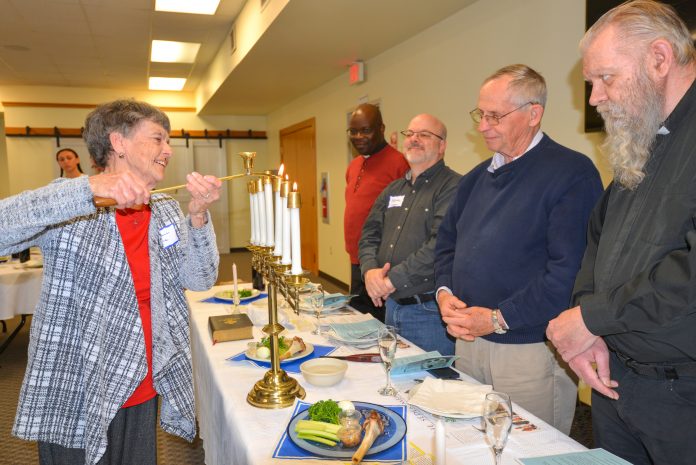The Catholic parishioners of St. Nicolas Church in Santa Claus gathered for a Seder Meal on Palm Sunday, April 2.
By tradition the Seder Meal celebrates and remembers the Passover night when God rescued the Children of Israel (i.e. the Jews) from slavery in Egypt.
The first question one might ask is why Catholics were celebrating and replicating a Jewish festival.
The explanation: “The Seder acknowledges our common roots. We believe in the same God. At the heart it’s not the temples and churches … it’s something as simple as sharing a meal and a cup of wine to give praise and thanks to God.”
This was a feast of freedom and redemption.
Passover is a springtime holiday and also celebrates the hope that comes from creation of the earth itself. For Jews it is an eight-day holiday commemorating the night the angel of death “passed over” the homes of the Israelites whose doorposts were marked with the blood of a lamb.
Fr. Noel, a priest and monk from Saint Meinrad Archabbey (could there be a more perfect name for a priest in Santa Claus?), conducted the ceremony with explanations, in similar fashion to that of our Jewish brethren.
The Hebrew word “Seder” means “order” or “arrangement” and the ritual of the meal is very specific, with a plate in the middle of each table containing an egg symbolizing the desire for freedom and a shankbone as a reminder of the lamb’s blood put on the doorpost of Jewish homes so the Angel would know to “pass over” that house; a sprig of parsley, symbolizing springtime, which is dipped in a bowl of salt water as a sign of the tears that must be shed before joy can be experienced; unleavened bread (matzah) representing bread made in haste before the Jews escaped Egypt; bitter herbs in the form of horseradish to represent the bitterness the Israelites endured before their escape from Egypt; mixed fruit called charoseth (apples and walnuts) to recall the mortar the Israelites were forced to make when they were slaves; and wine, drunk to honor the Lord.

The ceremony itself was very ritualistic, and as each step progressed Fr. Noel explained the significance. A program was provided so participants could give the appropriate response and join in singing “Psalm 34, The Cry of the Poor”, “Glory and Praise to Our God” and “Sing to the Mountains”, accompanied by Sherry Etienne on guitar.
When the ceremony and rituals ended it was time for the actual feasting to begin. Sprigs of parsley and a celery stick dipped in saltwater with unleavened bread do not a true meal make, even though Moses said, “You shall observe this rite as a perpetual ordinance for you and your children.” What Moses didn’t say was that you couldn’t add a tasty Jello salad and other delicacies to the celebration.





















